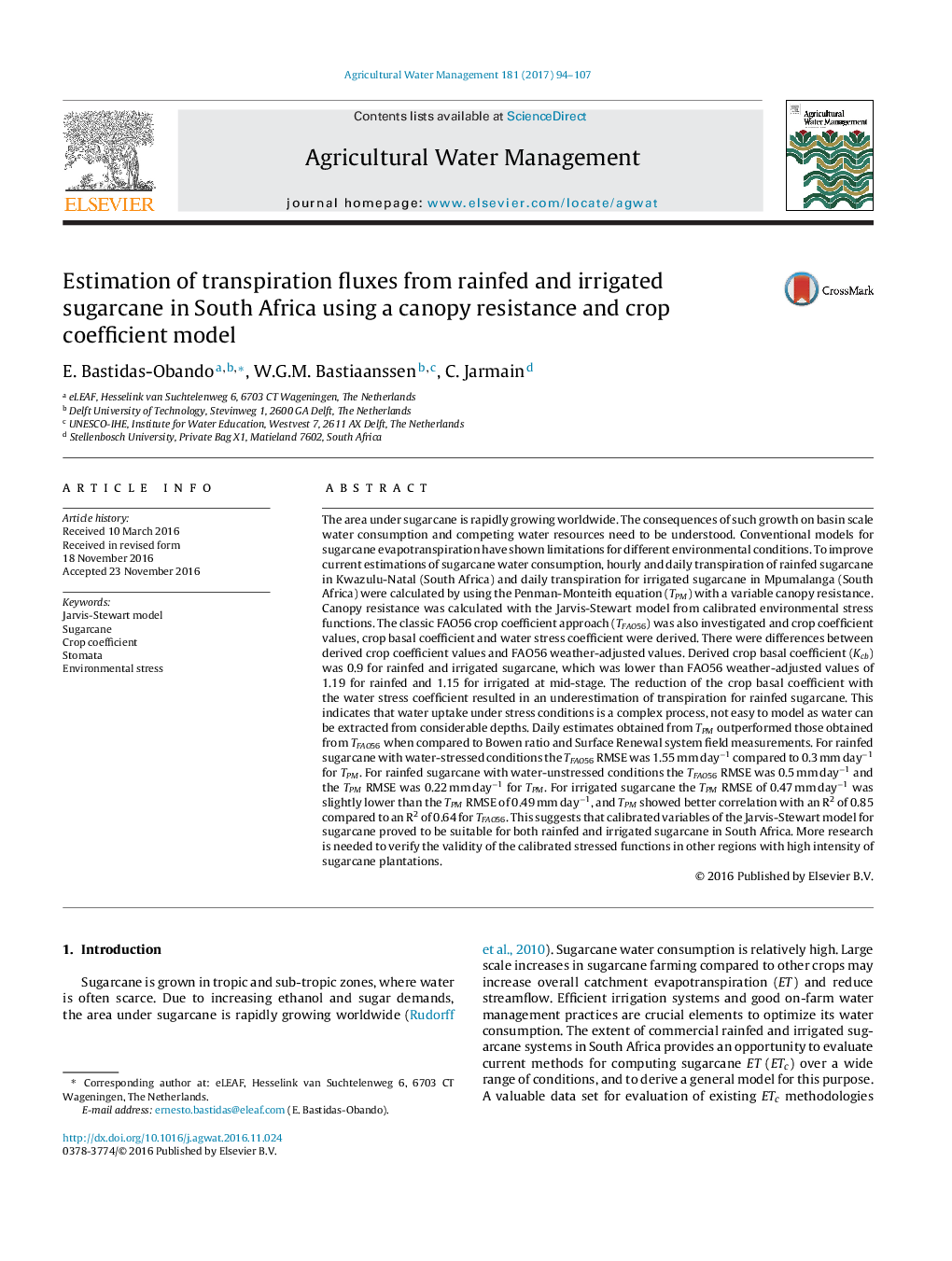| کد مقاله | کد نشریه | سال انتشار | مقاله انگلیسی | نسخه تمام متن |
|---|---|---|---|---|
| 5758578 | 1622899 | 2017 | 14 صفحه PDF | دانلود رایگان |
عنوان انگلیسی مقاله ISI
Estimation of transpiration fluxes from rainfed and irrigated sugarcane in South Africa using a canopy resistance and crop coefficient model
ترجمه فارسی عنوان
تخمین شیب تریپیراسیون از دیم و آفتابگردان در آفریقای جنوبی با استفاده از مقاومت سایبان و مدل ضریب محصول
دانلود مقاله + سفارش ترجمه
دانلود مقاله ISI انگلیسی
رایگان برای ایرانیان
کلمات کلیدی
موضوعات مرتبط
علوم زیستی و بیوفناوری
علوم کشاورزی و بیولوژیک
علوم زراعت و اصلاح نباتات
چکیده انگلیسی
The area under sugarcane is rapidly growing worldwide. The consequences of such growth on basin scale water consumption and competing water resources need to be understood. Conventional models for sugarcane evapotranspiration have shown limitations for different environmental conditions. To improve current estimations of sugarcane water consumption, hourly and daily transpiration of rainfed sugarcane in Kwazulu-Natal (South Africa) and daily transpiration for irrigated sugarcane in Mpumalanga (South Africa) were calculated by using the Penman-Monteith equation (TPM) with a variable canopy resistance. Canopy resistance was calculated with the Jarvis-Stewart model from calibrated environmental stress functions. The classic FAO56 crop coefficient approach (TFAO56) was also investigated and crop coefficient values, crop basal coefficient and water stress coefficient were derived. There were differences between derived crop coefficient values and FAO56 weather-adjusted values. Derived crop basal coefficient (Kcb) was 0.9 for rainfed and irrigated sugarcane, which was lower than FAO56 weather-adjusted values of 1.19 for rainfed and 1.15 for irrigated at mid-stage. The reduction of the crop basal coefficient with the water stress coefficient resulted in an underestimation of transpiration for rainfed sugarcane. This indicates that water uptake under stress conditions is a complex process, not easy to model as water can be extracted from considerable depths. Daily estimates obtained from TPM outperformed those obtained from TFAO56 when compared to Bowen ratio and Surface Renewal system field measurements. For rainfed sugarcane with water-stressed conditions the TFAO56 RMSE was 1.55 mm dayâ1 compared to 0.3 mm dayâ1 for TPM. For rainfed sugarcane with water-unstressed conditions the TFAO56 RMSE was 0.5 mm dayâ1 and the TPM RMSE was 0.22 mm dayâ1 for TPM. For irrigated sugarcane the TPM RMSE of 0.47 mm dayâ1 was slightly lower than the TPM RMSE of 0.49 mm dayâ1, and TPM showed better correlation with an R2 of 0.85 compared to an R2 of 0.64 for TFAO56. This suggests that calibrated variables of the Jarvis-Stewart model for sugarcane proved to be suitable for both rainfed and irrigated sugarcane in South Africa. More research is needed to verify the validity of the calibrated stressed functions in other regions with high intensity of sugarcane plantations.
ناشر
Database: Elsevier - ScienceDirect (ساینس دایرکت)
Journal: Agricultural Water Management - Volume 181, February 2017, Pages 94-107
Journal: Agricultural Water Management - Volume 181, February 2017, Pages 94-107
نویسندگان
E. Bastidas-Obando, W.G.M. Bastiaanssen, C. Jarmain,
